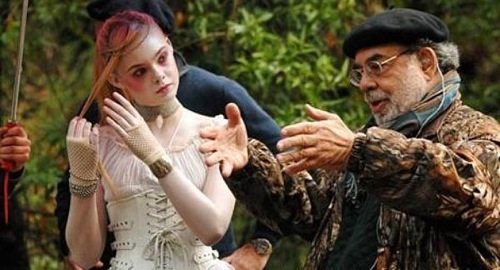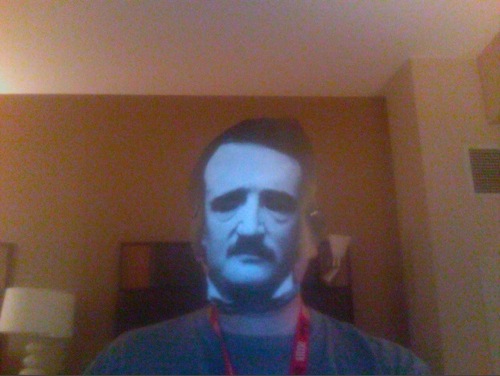
For a second there, Francis Ford Coppola's TWIXT looked like little more than an old-fashioned ghost story shot on some highly affordable DV cameras. Judging from the extended trailer, the film's central gimmick appeared to be a selective use of 3D; at random points during the movie, 3D glasses swipe across the screen, cueing viewers to don their specs. So Coppola was making his San Diego Comic Con debut in order to sell a slightly arty homage to the showmanship of William Castle - and, due to the paucity of production value (and the presence of a ghostly Edgar Allan Poe), perhaps an affectionate nod to his one-time benefactor, Roger Corman. A nice gesture, but, in terms of cinematic experimentation (which has been the filmmaker's m.o. for the last few years), hopelessly behind the times.
Then Coppola got out his iPad. "Theoretically, I could push this shuffle button and show you thirty versions of what I just showed you." An hour later, I was giddily dreaming about an entirely new way of making and presenting movies.
This October, Coppola and musician Dan Deacon will take TWIXT on the road for a series of live performances, during which they'll re-edit and re-score the horror film based on their own whims and the vibe given off by the audience. Since Coppola will have every scene - and every variation of that scene - accessible to him on his laptop, all of this will be done on the fly. Theoretically. Thus the true purpose of Coppola's visit to Comic Con: he wanted to do a "dress rehearsal" of the live show to see how/if it might work. It took me a while to figure out precisely what they were trying to accomplish (there were certainly plenty of technical glitches, especially with Coppola needing to be coached through the operation of the iPad), but once they got in a rhythm, I started to sense the possibilities. Improvisation based on classical narrative structure. It's cinematic bebop.
It's exciting to see the seventy-two-year-old Coppola playing innovator again - especially at a time when "innovation" seems to begin and end with 3D. "Cinema is so young," said Coppola at Saturday's funky Hall H panel. "How dare anyone think it doesn't have anything else up its sleeve but 3D and higher ticket prices." While Coppola obviously isn't anti-3D (or anti-higher ticket prices, as I'm sure this touring version of TWIXT will cost more than a regular trip to the multiplex), he doesn't believe the process should be applied to the entire film. Having watched significant chunks of AVATAR sans glasses, Coppola is in favor of presenting only select set pieces in 3D - which would alleviate headaches the process induces in many viewers, while also keeping them from adjusting to the enhancement. This has been done before (as far back as 1961's THE MASK, and possibly before that*), but it really is ideal.
But the use of 3D in TWIXT is really the least interesting thing about it (actually, the most interesting thing about the 3D was watching it through an Edgar Allan Poe mask, as pictured below); what really gets me excited is this notion of an ever-shifting moviegoing experience. Thirty years ago, Coppola attempted to move film production forward from an Airstream trailer called "The Silverfish" on the set of ONE FROM THE HEART; the idea then was to create an "Electronic Cinema" that would, via video playback, allow for each day's footage to be edited - and, perhaps, scored - as the shoot progressed (rather than waiting to piece the film together in postproduction). That was a costly experiment, one that brought Coppola's dream of an artist-driven studio to a sudden, debt-ridden halt. But whenever I'm hanging out in video village on a film set, I can see the partial implementation of what Coppola was trying to accomplish. He clearly understood where film production was headed.
And he might've had an idea of where it could go once moviegoers started craving an alternative to the canned theatrical exhibition of a finished film. Forget editing and scoring on set. What if the film wasn't ever truly finished? What if the journey wasn't predetermined? What if it could change from screening to screening? And what if you had a live, in-house band to roll with the adjustments like a jazz combo? Coppola, Deacon and TWIXT star Val Kilmer demonstrated how this might work during their Hall H "dress rehearsal", and, despite numerous snafus and restarts, actually won a good portion of the crowd over.
But there is one catch: the plot of TWIXT feels kinda humdrum. Kilmer plays a hack horror novelist who, while visiting a small town during a book tour, gets drawn into serial murder investigation by the eccentric local sheriff (Bruce Dern). Kilmer slowly becomes obsessed with the vampire-ish killings, which, for some reason or another, leads him to consult the ghost of Edgar Allan Poe (Ben Chaplin) in his dreams. He also encounters a sweet young girl named V (Elle Fanning, giving yet another great performance) who took up with a motorcycle-riding bad boy (Alden Ehrenreich), which may have led to her death or her being turned into a vampire. All of these dream sequences and flashbacks are shot in beautifully expressive black-and-white (with occasional color augmentation); they offer a striking contrast to the drabness of the color scenes.
While Coppola's cinematic technique may not be wholly breathtaking this time out, the notion of sitting in a theater and listening to him intone "Nos-fer-a-tu... Nos-fer-a-tu... Nos-fer-a-tu..." into a microphone over a hypnotically-edited dream sequence is irresistible. This is the kind of spontaneity Coppola is trying to achieve with the touring production of TWIXT, and it could be mesmerizing or silly or both - especially if Kilmer is in tow. Aside from the B&W sequences, the highlight of the TWIXT footage was watching a writers block-addled Kilmer ad-libbing bizarre lines into his laptop camera, segueing hectically from Colonel Kurtz to a gay 1960s NBA player who credits his short-shorts for improving his leaping ability. It's indulgent and spectacularly out-of-character, but the less conventional TWIXT gets, the better the movie - or, at least, the experience of watching it - is likely to be.
The touring production of TWIXT will consist of Coppola, Deacon's "band" (it seems like he might just DJ, but I might be wrong about that), and, possibly, three-screen projection ala Abel Gance's NAPOLEON. Coppola will have the option of dropping out Tom Waits's narration and performing it himself - and I suppose he'll be able to coordinate a mid-film, spoken-word "break" with Deacon if they feel the audience is into it. As for the narrative, Coppola told indieWire that it is "malleable", meaning it can get longer or shorter depending on which takes Coppola decides to use, but will always reach the same conclusion. So this is not Francis Ford Coppola's DR. SARDONICUS - though he, or another filmmaker inspired by the TWIXT method, could go that route in the future.
I have no idea whether the thirty-city TWIXT tour will be a revelation or a bust; I'm just thrilled Coppola is out there inspiring us to create and resist limitation. He's still dreaming. An improvisatory cinema reshaping itself in the moment based on the audience's reaction? The possibilities are myriad. At a certain point, viewers could become familiar enough with the narrative's shifting contours to induce a particular outcome - like rooting one's favorite sports team on to victory (during the panel, Coppola referenced the the harrowing experience of watching Team USA in the Women's World Cup Final). This might not be for you, but it's an option, a way to enhance the communal experience that won't fuck up your field of vision for two hours. It's one I'd love to see explored.
Faithfully submitted,

